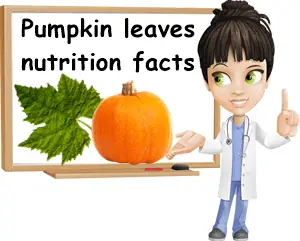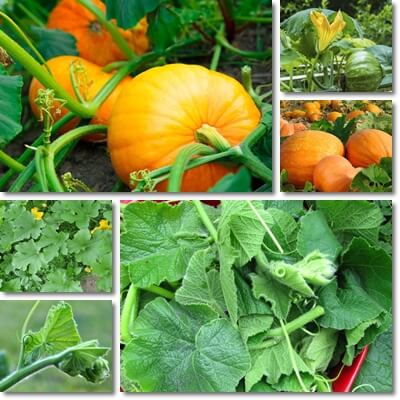We eat beet greens, turnip tops and dandelion leaves, bitter melon, jute and even sweet potato leaves. Why not eat pumpkin leaves as well? Pumpkin is edible in its entirety, not just the fruit with seeds, but also the flowers, young stems and leaves. Pumpkin leaves boast quite an impressive nutrition and are high in vitamin K and a good source of iron, magnesium, potassium, copper and manganese as well as pro-vitamin A antioxidants, lutein and zeaxanthin. As for their benefits, pumpkin leaves have are low-calorie but energizing and filling and good for anemia-related fatigue and muscle weakness, high blood pressure and poor blood coagulation.
What do pumpkin leaves look like?
The whole pumpkin plant trails along the ground and looks massive. Mature pumpkin leaves are large, deeply lobed and dark green in color, slightly lighter underneath the leaf. They are leathery, but rough on top, with serrated margins that sting upon touch. The older leaves may look crumpled. Underneath, the leaf feels rough. The veins are more prominent underneath the leaf, hairy and prickly. The stem attached to the leaf is also hairy and prickly, empty inside and fibrous in more mature leaves.

Are pumpkin leaves edible raw or cooked?
All the parts of an edible pumpkin variety are typically also edible: pulp, seeds, flowers, young shoots and leaves, even the rind.
Edible pumpkins are known to be non-toxic which means they can be eaten safety both raw and cooked, and so can the leaves. But because the leaves are hairy and rough and prickly, and taste like plain greens (although better than most other greens), they are preferred cooked.
Very young pumpkin leaves and shoots can be eaten raw. Pumpkin leaves that are too old become wilted, dry and rough at the edges and change color from green to yellow and reddish-brown.
Pumpkin leaves cook down significantly, similar to other leafy greens.
What do pumpkin leaves taste like?
Pumpkin greens, that is, leaves and stems, are great as food. Cooked pumpkin leaves taste like greens, but without the bitter flavors. They are actually quite pleasant, with a taste reminiscent of sweet green beans. Young leaves have more tender stems and can be eaten together.
For the best taste experience, discard stems in older leaves by snapping them off and pulling them backwards – this helps remove all the tough, fibrous material off and leaves only the tender pumpkin leaf. Alternatively, you can just cut the stems and tough parts using a knife.
Also, avoid leaves that are too old. Instead, choose large, fully-formed, but still tender leaves of a uniform dark green color, without any discoloration or damage. Avoid pumpkin leaves that do not look nice or healthy, or have holes in them or dry edges or a gray or white powdery residue on them.
The gray or white stuff on pumpkin leaves is actually mold. The disease it causes in pumpkins is known as ‘powdery mildew’ and affects the leaves by causing grayish or white spots of residue that ultimately lead to leaf loss, but can also affect the fruit.

Pumpkin leaves nutritional information
Pumpkin greens are edible as well as nutritious.
Their nutrition is similar to that of other leafy greens. That is, pumpkin leaves are a good source of dietary fiber, iron, copper, manganese, magnesium, potassium and pro-vitamin A and high in vitamin K.
They are also a modest source of protein, low-carb and low-calorie and very low-fat, but cholesterol-free.
Pumpkin leaves contain small amounts of several essential vitamins and minerals, notably B vitamins, calcium and phosphorus and trace amounts of vitamin C, vitamin E, choline, selenium, sodium and zinc, but no vitamin D and no vitamin B12.
Cooked pumpkin leaves (boiled and drained) nutrition facts per 100 grams
- Energy value: 21 kcal (kilocalories, calories)
- Carbohydrates: 3.4 grams
- Sugars: 0.7 grams
- Dietary fiber: 2.7 grams
- Protein: 2.7 grams
- Fat: 0.22 grams (saturated and unsaturated)
- Cholesterol: 0 mg (milligrams)
- Vitamin A: 80 mcg (micrograms) primarily from beta-carotene
- Beta-carotene: 960 mcg
- Vitamin B1: 0.068 mg
- Vitamin B2: 0.136 mg
- Vitamin B3: 0.85 mg
- Vitamin B5: 0.042 mg
- Vitamin B6: 0.196 mg
- Vitamin B9: 25 mcg
- Vitamin B12: 0 mcg
- Choline: 21 mg
- Vitamin C: 1 mg
- Vitamin D: 0 mcg
- Vitamin E: 0.96 mg
- Vitamin K: 108 mcg
- Calcium: 43 mg
- Copper: 0.133 mg (133 mcg)
- Iron: 3.2 mg
- Magnesium: 38 mg
- Manganese: 0.355 mg
- Phosphorus: 79 mg
- Potassium: 438 mg
- Selenium: 0.9 mcg
- Sodium: 8 mg
- Zinc: 0.2 mg
Antioxidants in pumpkin leaves include:
- Vitamins A, E.
- The minerals copper, iron, manganese.
- The pigmented antioxidants beta-carotene, lutein, zeaxanthin, chlorophyll.
- Other polyphenols.
15 Pumpkin leaves benefits
Can you eat pumpkin leaves? Yes, you can. Not only are the unusual greens edible, but they’re also nutritious enough to fund a range of benefits for health such as:
1-Depurative properties
Pumpkin leaves and other leafy greens have a laxative effect, stimulating transit and promoting bowel movement regularity, producing a detoxifying effect.
2-Cholesterol-lowering properties
It’s not just that pumpkin leaves are cholesterol-free – they’re also almost fat-free and a good source of fiber and vitamin B3 which help lower LDL (bad) cholesterol and possibly also improve HDL (good) cholesterol levels.
3-Blood sugar-lowering properties
Pumpkin leaves are low-glycemic index and low glycemic-load, low in carbs, but a good source of fiber and help lower blood sugar. Their nutritional profile is the reason behind their hypoglycemic effects.
4-Good for eyesight
Pumpkin leaves are a good source of pro-vitamin A beta-carotene and lutein and zeaxanthin antioxidants. Once absorbed, the nutrients become part of the retina and macula lutea areas of the eye and promote the physical health of the eye as well as good visual acuity, color vision and low-light vision.
5-Benefits for high blood pressure
Pumpkin leaves are naturally (almost) sodium-free and a good source of dietary potassium (9% of daily requirements) and magnesium (9.5% of daily requirements) and thus good for hypertension, helping lower high blood pressure numbers.
6-Benefits for anemia
With almost 18% of daily requirements of iron per 100 g serving, pumpkin leaves combat anemia and associated symptoms such as fatigue and muscle weakness.
7-Helps make red blood cells
Eating cooked pumpkin leaves provides generous amounts of iron as well as vitamins B6 and B9 which help make red blood cells and hemoglobin in red blood cells with benefits for anemia and fatigue.
8-Potential benefits for palpitations
Eating pumpkin leaves is good for iron deficiency-caused palpitations, breathlessness and other similar symptoms because the greens are high in iron.
Note: To maximize iron absorption from greens and other plant foods, eat them with a source of vitamin C, whether it’s a fresh fruit with a good content of vitamin C or you take a dietary supplement right after eating.
9-Energizing and revitalizing
The energizing and revitalizing action of pumpkin leaves is owed to their nutrition, namely content of iron and B vitamins such as vitamins B6 and B9. The good iron content and varied B vitamin content contribute to red blood cell production and the production of hemoglobin, boosting vitality.
10-Help you lose weight
Pumpkin leaves are satiating and filling as a result of a good content of dietary fiber, but low-calorie and very low-fat at the same time. This makes them a good food to eat in a weight loss diet and one that contributes to healthy weight loss.
11-Benefits for pregnant women
Pumpkin leaves have a good content of iron and a varied B vitamin content. Regular consumption contributes to the production of red blood cells and hemoglobin in red blood cells which translates into benefits for energy metabolism and increased vitality. Not just this, but eating the leaves supports the expanding circulatory system of the pregnant woman and helps successfully bring the pregnancy to term.
12-Benefits for digestion
Cooked pumpkin greens are mucilaginous and easy on the stomach and can help weather stomach upset. They are best eaten with an absorbent food such as white rice, white pasta, white bread or toast.
13-Promote normal blood coagulation
High in vitamin K, pumpkin leaves can help prevent easy bruising and nosebleeds caused by a deficiency of the vitamin. However, limit consumption of all high vitamin K foods if you have a predisposition for blood clots or are taking anticoagulant medication.
14-Benefits for skin
What makes pumpkin leaves good for skin health is a good content of vitamin A paired with a varied B vitamins profile. Vitamin A, or provitamin A to be more exact, is involved in cell turnover and regulates skin cell renewal. Not just this, but vitamin A protects the integrity of skin and exerts antioxidant benefits, while B vitamins counteract skin inflammation and combat dry skin.
15-Potential benefits for fertility
It has been proposed that pumpkin leaves are good for fertility in men due to their content of zinc and manganese, and help support female fertility starting from the pre-conception period and throughout pregnancy via essential micronutrients such as B vitamins and vitamin C.
5 Pumpkin leaves recipe ideas
Pumpkin leaves are edible, nutritious and taste nice, but how do you eat them? Just like you would any other leafy greens. African, Middle Eastern, Asian and also Central and Eastern European cuisine all make great use of all sorts of unusual garden greens and field greens, including pumpkin. And the recipes to incorporate them in are endless. Here are some delicious examples:
1-Italian-style vegetarian pumpkin leaves lasagna
Make the lasagna as you normally would. But in between the lasagna layers add chopped pumpkin leaves stir fried with finely chopped onion, grated ricotta or Parmesan on top and the classic bechamel sauce. Optional: add tomato sauce.
2-Pumpkin leaves rolls (Eastern European cuisine influences)
The tough stem and fibrous material are removed from the leaves, after which they are blanched. A mixture of rice and meat, rice and vegetables, rice and raisins or dried plums, meat and vegetables, or just vegetables is prepared and rolled into the leaves.
Usually the rice is fully boiled, while the meat and vegetables are only half-cooked (for flavor mostly). The rolls are then boiled until soft. If the recipe is meat based, stuffed pumpkin leaf rolls can be cooked with pieces of pork ham or lard for more flavor.
3-Pumpkin leaves soup (Eastern European recipe)
A traditional Eastern European-style soup. An onion is chopped finely, then sauteed in a vegetable oil. Pumpkin leaves and sometimes also tender stems are cleaned and large chopped; the sauteed onions are added and then everything is boiled. The resulting soup is seasoned with salt and soured with green plums or green cherry plums.
4-Simmered down pumpkin leaves with onion or garlic
A favorite recipe for leafy green enthusiasts. Clean and large chop pumpkin greens (leaves and tender stems), them simmer down in a little bit of water for a few minutes. Stir fry with minced garlic or finely chopped onion. Season simply with salt. Tomato sauce may also be added for a more acidic flavor, hot chili pepper for spiciness or grated carrot for a little bit of sweetness. It can be eaten as it is or added on top of spaghetti or rice.
5-Quick beans and pumpkin leaf recipe
Canned beans of your choice. Drain and throw in a pan with olive oil and large chopped pumpkin leaves until the greens cook down. Season with salt and pepper. Optional: add sauteed onions.
